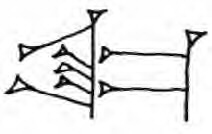Writing systems; signed and spoken language. Language and thought.
Writing language
Linguists generally agree with the following statement by one of the founders of the modern science of language.
|
Writing is not language, but merely a way of recording language by visible marks. Leonard Bloomfield, Language (1933) |
Some version of this is clearly true, as we can see by looking at the history of the human species and of each human individual. In both regards, spoken language precedes written language.
| Speech | Writing |
| Present in every society | Present only in some societies, and only rather recently |
| Learned before writing | Learned after speech is acquired |
| Learned by all children in normal circumstances, without instruction | Learned only by instruction, and often not learned at all |
| Human evolution has made speaking easier | Evolution has not specifically favored writing |
Another way to express Bloomfield's point is to say that writing is "parasitic" on speech, expressing some but not all of the things that speech expresses. Specifically, writing systems convey the sequence of known words or other elements of a language in a real or hypothetical utterance, and indicate (usually somewhat less well) the pronunciation of words not already known to the reader. Aspects of speech that writing leaves out can include emphasis, intonation, tone of voice, accent or dialect, and individual characteristics.
Some caveats are in order.
In the first place, writing is usually not used for "recording language" in the sense of transcribing speech. Writing may substitute for speech, as in a letter, or may deploy the expressive resources of spoken language in visual structures (such as tables) that can't easily be replicated in spoken form at all.
In the second place, writing systems may include some conventions that are substantially independent of speech. For example, Geoff Nunberg has argued that punctuation in English is not only or even primarily a representation of the phrasing and intonation of spoken English, but rather an autonomous system for indicating certain kinds of textual relationships. Also, words that are pronounced the same way may not be written the same way ("homophones"), and vice versa ("homographs").
Still, Bloomfield was basically correct: writing is a way of using "visible marks" to point to pieces of real or potential spoken language.
Types of writing
Here are the traditional terms for different types of writing systems; in fact they're best treated as ways to talk about particular symbols rather than entire sytems, since particular systems often mix types of symbols.
|
Ideographic (idea-writing): The sign refers to an idea or general concept, not a specific word of some language; therefore this is not true (linguistic) writing. |
Societies exclusively use ideographic symbols until writing is invented or borrowed. The Dakota Indians of the northern plains of the U.S. on occasion used a series of symbols, one for the passage of each year (or "winter"), to keep track of events beyond the memory of living individuals. A famous example of such a winter count was maintained by Lone Dog of the Yankton band of Dakotas, living in Montana; it runs from 1800-1871.
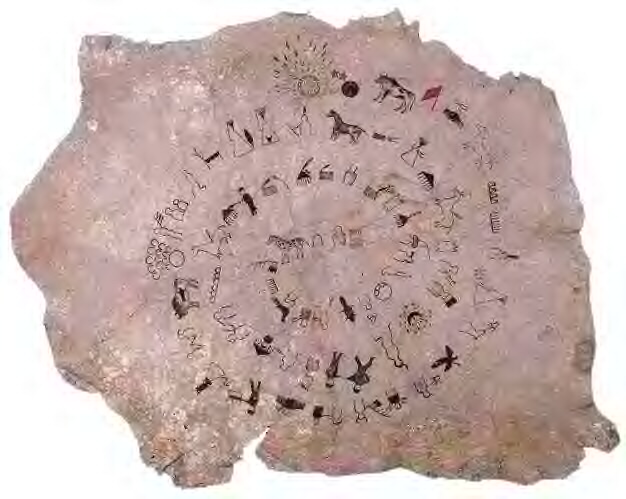
The symbols begin in the center of a buffalo hide and spiral outward. These symbols are examples of ideographic proto-writing, since they are not connected to particular words, but rather to events or ideas that are suggested by the images. Symbols that are pictures (more or less) of the thing they represent are called pictographs.
For example, in 1823-24 white soldiers made their first appearance in the region, and attacked an Arikara fort. (Garrick Mallery's Picture-Writing of the American Indians, 1893, pp. 266-287.)

This design serves to remind the interpreter of the count of that event; but much of the detail has to be provided by memory. In other words, it is a mnemonic.
In societies with writing, ideographs are still quite useful, particularly when a symbol independent of a particular language is desired. Road signs and other public signs are increasingly ideographic in today's world.

The written word restroom would be of use only to a (literate) speaker of English, whereas this symbol is easily learned regardless of a person's linguistic background. The kinds of messages that can be conveyed without reference to language are quite limited, however.
Ideographic systems as such have never developed into a form fully capable of conveying unlimited messages from one person to another. Instead, they either remain as limited systems operating within a highly restricted application -- say, to keep warehouse records or direct traffic -- or else they develop into a genuine writing system, capable of conveying any linguistic message. In the second case, the process of development into a genuine writing system always involves adding some phonetic aspects, in ways we'll describe shortly.
|
Logographic (word-writing): Each sign refers to a specific word (or rather, a "morpheme"), not just the general idea behind that word. |
The notion of "word" is not entirely correct here; instead, the right idea is "morpheme," the minimal unit of meaning we learned about in the morphology lecture.
All the early writing systems of antiquity are heavily logographic, because what happens at the beginning of writing is a shift from idea to word as the element being represented by a symbol.
For example, this depiction of a scribe's tools stands for the Egyptian word originally pronounced something like ziçiR, meaning "write" (Some details of Egyptian pronunciation are subject to debate.) It is a logograph.
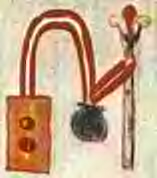
Similarly, this Chinese symbol (when read in Mandarin) stands for the word ma 3 (the "3" means falling-rising tone), meaning "horse." (It's a simplification of what began as a drawing of a horse.)

Nothing about these representations indicates the pronunciation; this lack is one of the basic characteristics of a logograph as an individual symbol. Some more examples from Chinese:
 |
 |
 |
 |
 |
 |
 |
 |
|
ren 2 "person" |
mu 4 "tree" |
huo 3 "fire" |
shui 3 "water" |
shan 1 "mountain" |
kou 3 "mouth" |
shang 4 "above" |
xia 4 "below" |
But all writing systems involve reference to pronunciation in some way, including Chinese for the great majority of its characters, as we'll see below.
|
Syllabic: Each sign refers to a syllable, typically a consonant plus a vowel. |
An example of a script in which each symbol normally represents a syllable is the hiragana syllabary of Japanese. (It's just one part of the complex Japanese writing system.) Here's the word watakushi, meaning "I" (a polite form).

Notice that each symbol stands for a consonant plus a vowel -- just four symbols are needed, as opposed to the nine used to write it in English letters. There are two Japanese syllabaries:
hiragana, for native vocabulary including suffixes
katakana, for borrowed vocabulary such as English words
Both sets of syllabic symbols are shown in this chart (hiragana on top). Notice that voiced obstruents are indicated by adding two small strokes to the symbol for the corresponding voiceless consonant; and /p/ is derived from /h/ by adding a small circle.
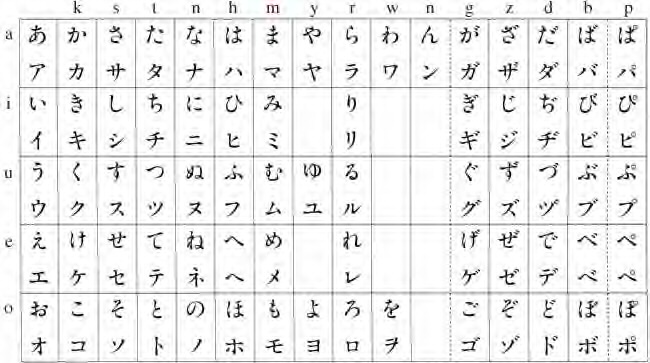
The nearly empty column labeled "n" gives the symbols used when /n/ occurs at the end of a syllable. Japanese also makes great use of originally Chinese characters, in ways too complex to describe here.
While some basic symbols in Chinese are truly logographic, including the ones we saw above, the great majority of characters actually consist of two parts: one that tells about meaning, and one that indicates (with varying accuracy) the pronunciation. So the ma 3 "horse" character above functions as a phonetic indicator in the following character for "mother," which points to the spoken word ma 1 with a high tone. (The left side of this character means FEMALE.)

Since the "horse" component indicates the pronunciation of the whole syllable [ma], it is a syllabic symbol.
For each component character, one part is the phonetic, and the other is the semantic; generally the rest of what that character expresses independently is ignored. Thus in "mother" above, the left character means FEMALE, while the same character, as part of "servant" below, is used for its sound [nü].
 |
 |
|
nü 3 "female" |
nu 2 "servant" (with HAND) |
The resulting compound character has a particular pronunciation, of course, so it can also be used as the phonetic in other, denser characters. For historical reasons, this is quite common.
 |
 |
 |
|
nu 2 "servant" |
nu 3 "work" (with STRENGTH) |
nu 4 "anger" (with HEART) |
In the majority of cases, seen also here, the phonetic component of the character is an imperfect reflection of the pronunciation (sometimes the tone is different, sometimes the consonant or vowel, sometimes all of them).
The important point is that Chinese, though in some ways logographic, also has a large phonetic aspect to its symbols -- more exactly, a syllabic one. The imprecision of the phonetic aspect is analogous to the irregularities of English spelling.That is, English spelling usually tells us what the morphemes are, but unless we know in advance, it often gives us only imperfect information about pronunciation. We can be sure that "tough" will not be pronounced "congressional" or "book", but only knowledge of the word itself tells us that it rhymes with "rough" and not with "dough" or "through" or "plough".
|
Alphabetic: Each sign refers to a single sound, whether a consonant or a vowel. |
This type of script hardly needs illustration, since English uses the Latin alphabet. But there are several aspects of English spelling that depart from a "pure" alphabet.
Digraphs, or the use of two letters to write a single sound; as well as rarer trigraphs.
- fish, chin, thin
- see, too, saw
- watch
Silent letters that aren't pronounced at all.
- caught
- give
There are, of course, also many inconsistencies and irregularities in the use of the symbols.
Homographs, or the same spellings with different phonetic values.
- meat, great, bread
- I read it yesterday
- I'll read it tomorrow
- ether, either
Homophones, or different spellings with the same phonetic values.
- bread, red
- off, cough
These "impurities" don't change the fact that the basic nature of the system is one symbol per sound -- that's the standard from which these examples deviate (rather than, say, a syllabic standard).
Whether or not digraphs are necessary depends on the resources of a particular alphabet, and what sounds need to be written. Borrowed words often present special circumstances.
For example, the Cyrillic alphabet has many letters for which English (or the Latin alphabet more generally) needs to resort to digraphs and even more complex solutions. Consider the Russian name Khrushchev.
This word is transliterated kh-r-u-shch-e-v. Notice the digraph kh and the tetragraph (?!) shch. Since the Latin alphabet has no equivalents, these new combinations are necessary to render the Russian letters. (In cases like this, hyphens are helpful in showing the equivalents of each letter.)
Of course, sometimes it's another language that needs to resort to these strategies when borrowing an English word.
German, for example, has no letter for the consonant sound in judge (that sound is absent from native German words.) So in borrowing the word jungle, it actually needs a tetragraph as well.
Dschungel
By the way, the word jungle came into English from Hindi, where there is also a single symbol for that initial consonant sound. So here English didn't have to resort to a digraph: the two languages' scripts were nicely compatible.
There are many other kinds of alphabets as well. One sub-part of the Egyptian writing system was alphabetic, though originally it indicated only consonants (like the Semitic alphabets that are probably descended from Egyptian).
One example is the word twt, meaning "image," which we can render as toot. The little loaf of bread stands for the sound [t], and the quail chick for the sound [w].

This was the first part of the name Tutankhamun, literally "living image of Amun."
The modern Semitic alphabets work in a similar way. In Hebrew, for example, only certain vowels are written (as secondary functions of consonant characters), and there can be multiple ways of reading a word. (These alphabets are written from right to left.)
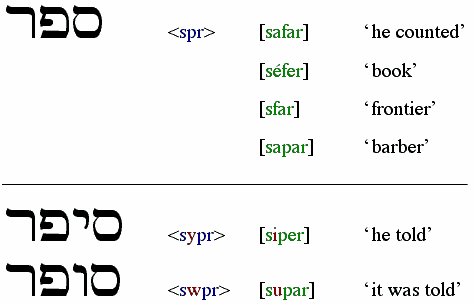
In Arabic, in can be trickier to identify the letters, since most of them have to be connected up in cursive fashion. Here's one example with three letters.

Since in everyday writing short vowels are not written, and doubled consonants are not distinguished, this word can be read in several ways, including:
kataba "he wrote"
kutiba "it was written"
kattaba "he caused to write"
kutub "books"
Context generally makes things clear, just as it does for ambiguous English written words like read and bow. But of course English writing, while extremely ambiguous if one is trying to pronounce unfamiliar words, is less ambiguous once you've learned it than a script that leaves out vowels entirely. For example, while you can't be sure whether ea will be pronounced [i] or [E] in a particular word, you can be quite sure it won't be pronounced [a], [o], [u], [aw], [oy], [ay] or any number of other possibilities. So the Semitic alphabets which do not write the vowels are more ambiguous than English orthography. But there seems to be a reason for this. As suggested by the examples above, Semitic words generally have a root made up of three consonants, with the vowels in between indicating derivational and inflectional variants. Information of this sort can generally be gleaned quite easily from the context. Because of this structure, it is very rare that the lack of vowels would leave unclear which root is involved, so the following two possibilities, which would be indistinguishible if we wrote English without vowels, would be quite distinct in a Semitic language:
He's leading/loading the donkey.
Origins of writing
The following map shows the dates at which a number of writing systems first appeared (some much earlier than others).
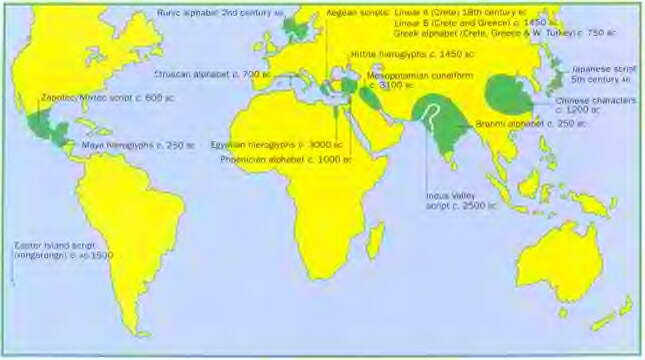
Writing was perhaps invented four different times in the history of the world, though the exact number is a matter of debate. (For example, there's good reason to think that Egyptian writing was inspired by contact with Sumer, but the system itself was a new creation.) These dates are debated as well.
| Sumerian | 3200 BCE |
| Egyptian | 3050 BCE |
| Chinese | 1200 BCE |
| Maya | 292 CE |
The earliest writing seems to have arisen in southern Mesopotamia (modern Iraq), among the Sumerian people, between 3200 and 3000 BCE. (Egyptian writing arises at nearly the same time, and was possibly inspired by it in some way.) They developed a system of icons inscribed on clay tablets for keeping temple economic records.
A typical example includes icons for "two", "sheep", "house" (also "temple"), and the goddess "Inanna" with the general symbol for "god" used to identify divine beings. These diagrams show the original pictures; the Sumerian words; and the English translations.

Such early documents are difficult to interpret, largely because they lack indication of verbs and the interrelations of nouns -- precisely what full language excels at. The meaning might be
"two sheep received from the temple of Inanna", or
"two sheep delivered to the temple of Inanna",
or perhaps something else entirely.
Thus these marks constituted a limited notation system, which in the beginning may only have served to remind the writer of what he had once already known (a mnemonic, like the Dakota winter count). However, as long as agreed-on standards were obeyed, another person could also read the record in the same way.
In this regard, these early documents were similar to many systems for record-keeping, based on symbolic tokens of many sorts, developed over and over again in many cultures over the millennia -- marks on stone or bone, clay figurines, even knots in cords. As civilizations become more complex, however, record-keeping needs become increasingly complex as well. The ability of trained third parties to read such records in a consistent way becomes increasingly important for mediating or adjudicating disputes in non-violent ways.
In the case of the Sumerian record-keeping system, two crucial innovations led (over a few hundred years) to a full writing system, capable of expressing anything that could be expressed in the (written) words of the Sumerian language.
The first innovation was the Rebus Principle: if you can't make a picture of something, use a picture of something with the same (or similar) sound. That is, when a word for some easily drawn object was homophonous with (had the same pronunciation as) some more abstract word, the originally pictographic sign could be used for the homophonous word as well.
For example, the following sign for a "water" was originally two wavy lines. It was also used for the preposition "in" which in Sumerian had the same pronunciation.
 |
|
It also soon came to mean the sound [a] in general -- regardless of the meaning of the word in which it occurred -- thereby acquiring a truly phonetic use. For example, it could be used to help write the suffix ani meaning "his" or "her."
Similarly, a picture of the concrete object gi "reed" was used for the abstract verb "reimburse." This is the world's first clear example of rebus, in a tablet from Jemdet Nasr, dated to around 2900 BCE.
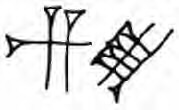 |
|
Such rebus extensions solve the problem of writing words for abstract concepts, though they also create a new problem of ambiguity -- but no more so than any phonetic writing system that writes homophonous words identically (such as English bank for the edge of a river and for a financial institution).
The second innovation was what we might call the Charades Principle: if you combine an ambiguous or vague picture of the meaning of a word, with a little information about what the word sounds like, you can get a more effective communication of the identity of the word than if you tried to use only imperfect information about meaning, or imperfect information about sound.
To give an example from Sumerian, the basic meaning of the following sign was KA "mouth."
But it also had other readings. For example, it was augmented with the phonetic me to create EME "tongue".
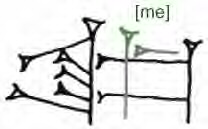
Similarly, it is augmented with nun to create NUNDUM "lip".
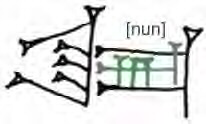
Thus a Sumerian reader was in effect being asked to play a sort of game of charades: what word has something to do with "mouth" and sounds like [me]? -- why of course, that's EME, "tongue"! These combinations became conventionalized, resulting in a system that was presumably somewhat easier to learn to read than to learn to write, but was not very efficient in either direction.
Still, the result was a complete writing system, in which the Sumerians wrote down not just warehouse records, but poems, diplomatic treaties, letters, contracts and judicial decisions, dictionaries, and epic myths.
A modern version of a similar "charades" system is what we've already seen for Chinese characters. Recall that most characters can be analyzed as containing two elements, one of which provides semantic information, while the other provides phonological information, as in the FEMALE and [ma] of "mother."

It's important to note and remember that these "charades" are completely conventionalized: an educated reader of Chinese doesn't have to guess every time a familiar character is seen. But when a rare or unfamiliar character is encountered, this is precisely the sort of guessing strategy that could reveal the word to which the character refers without consulting a dictionary.
It is clearly inappropriate to call the Chinese system "ideographic", as is sometimes done. Chinese characters refer to specific morphemes, not vague ideas. However, Chinese characters are simultaneously a kind of syllabic writing, since the phonetic element is always a syllable in size. The term "morpho-syllabic" has been created to describe it.
No one has ever developed a full communications system based on ideographic principles, although people have often surmised that this would be useful, because it would (or at least could) be universal. The problem is that "universality" means only that it is equally hard for everyone to develop and learn such a system. If it is feasible to design such a system at all, it is at least very, very difficult.
The problem is this. The number of ideas that can be expressed by language is huge, and the idea expressed by a word is actually quite precise. When we say house we do not mean any place where someone can live, or any sheltering structure or even the same thing as we mean when we say home. These distinctions are important, and in order to be as communicative as normal language, a fully ideographic system would have to be able to make them clearly, but it is not clear how this would be done simple by altering the picture. In order to be certain that the person reading the sign would understand precisely what the writer meant, a certain amount of conventionality would have to be introduced. Once this happens, though, we are left again with a system that must be learned. The more expressive we want it to be, the more will have to be conventionalized, and the more will have to be learned. In order to be as fully expressive as a natural human language, our ideographic communication system would probably require about as much learning as any other language. We would be left then with something like Esperanto, an interesting attempt which will raise a certain amount of interest and have a certain amount of success, but will probably ultimately fail because it's simpler to use a language that at least one part of the population already speaks.
Since everyone already knows at least one ordinary spoken language, practical people will always tend to give up on the ideographic system and start using a written form of their speech, as soon as they can figure out how to do this.
But this is no easy task. It is rather difficult to get enough conscious access to the phonological structure of speech to design an alphabetic writing system, and very few languages have small enough inventories of syllables for a syllabic system to be an easy place to start. More importantly, the idea of constructing a full writing system (on any basis, phonological or otherwise) is not at all an obvious one.
So writing seems to have started with pictograms for mnemonic aids in record keeping, as seen above, or as vehicles of insight in divination. As the inventory of signs increases, the possibility arises to begin using some of the signs as rebuses or as phonological/semantic combinations. This is much more efficient than trying to design a new symbol for every word or morpheme. Once this meaning-plus-sound process begins, it can develop into a full (if complex and inefficient) writing system, able to encode any passage in the language. This development seems to have occurred independently at least three times: in Mesopotamia; in China; and in Mesoamerica.
Various other developments are then logically possible. The Chinese (and other cultures influenced by them, including Japan) developed a meaning-plus-sound system based on the syllabic unit. The Mayans did the same. A logical next step is to increase efficiency by doing away with some or all of the meaning-related units in favor of a consistent syllabary of some sort. Such syllabaries were developed throughout East Asia, but in most cases they did not displace the meaning-plus-sound elements. Instead they supplemented them for certain uses (such as the encoding of grammatical particles in Japanese) or for certain populations (such as women in some places and periods in China).
By contrast, the Egyptians developed a meaning-plus-sound system based on consonants. This naturally led to purely consonantal writing systems for some of the Semitic languages, notably Phoenician.
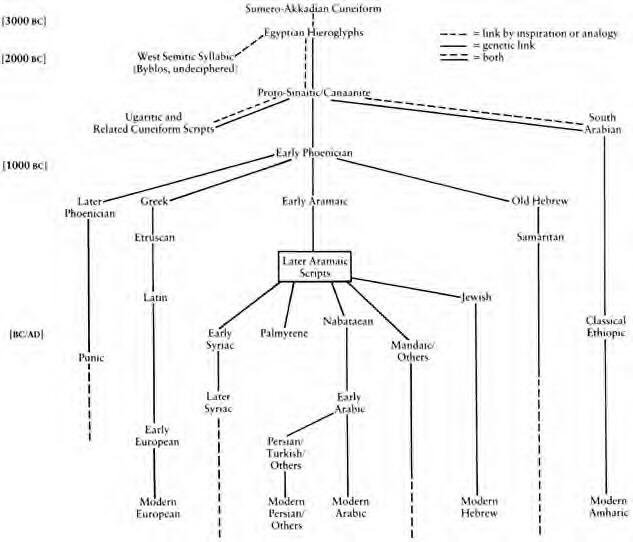
It was the Phoenicians who brought the alphabet to the Greeks. The innovation of the Greeks was to invent vowel letters -- but this was essentially by accident, since the Greeks misheard some Phoenician words starting with unfamiliar "guttural" consonants as starting with vowels. For example the greek letter alpha, ancestor of modern A, represents a glottal stop ['] in the semitic languages (the corresponding Hebrew letter א is called 'aleph). They thus used the symbols for these unfamiliar consonants to stand for the vowels of their language, and the first full alphabet, with special symbols for individual vowels and consonants, was born.
Flexibility of writing systems
In principle, any fully linguistic script can be used to write any language; this is proved by the fact that foreign names can be rendered in new scripts. Scripts are just better adapted to some languages than to others, especially with respect to the individual sounds (in any script) and sound combinations (in a syllabary) that need to be expressed.
In addition, the history of writing is filled with examples of scripts adapted to new languages, often unrelated and of very different structures. Some examples:
| Developed for... | Used for... |
| Sumerian | Akkadian Hittite |
| Chinese | Japanese Korean Vietnamese (formerly) |
| Arabic | Persian Urdu Turkish (formerly) |
| Hebrew | Yiddish Ladino |
| Latin | English and hundreds more |
These examples could easily be multiplied. These adaptations involves changes of varying degrees, such that the result may sometimes be considered a new script (such as Greek as adapted to Etruscan, Latin and Old Church Slavic).
Along the same lines, what is essentially the same language can be actively written in different systems. Sometimes this depends on ethnicity or religion, other times on historical shifts.
| One language... | Different scripts... |
| Hindi Urdu |
Devanagari Arabic |
| Serbian Croatian |
Cyrillic Latin |
| Turkish
(pre-1928) Turkish (post-1928) |
Arabic Latin |
| Vietnamese
(pre-1910) Vietnamese (post-1910) |
Chinese Latin |
| South Korean (less and
less) North Korean (post-1949) |
Chinese plus
hangul alphabet Pure hangul alphabet |
| Egyptian Coptic (Late Egyptian) |
Hieroglyphs Coptic alphabet (from Greek) |
Once a writing system is "full", i.e. includes a way to write sounds, it's possible (though not always convenient) to use that system to write any language. The point of having a phonetic alphabet such as the IPA is to be able to write down any language at all in the most convenient way.
Sign Language
Signed languages are visual-spatial languages used as the primary means of communication by communities of deaf people in various parts of the world. The Ethnologue index currently lists 114 Deaf Sign Languages throughout the world.
Like any other language, a sign language requires a language community to develop and to be maintained. In many traditional societies, where deaf people live out their lives in the small communities in which they are born, there is not the "critical mass" of signers needed to create a true sign language. Instead, each deaf person develops an ad hoc sort of pidgin sign language to use with his or her relatives and neighbors.
In Nicaragua, this was the situation until about fifteen years ago, when a residential school for the deaf was established in Managua. Within a few years of the establishment of this school, a full-fledged Nicaraguan sign language came into existence. Pinker discusses this briefly in chapter 2.
A crucial indication that sign language is not just functionally equivalent to spoken language, but in some sense the same thing as far as the brain is concerned, comes from aphasia. Since the modality of input and output is so different in spoken and signed forms of language, we might expect them to be handled by very different parts of the brain, the former perhaps associated with control of the mouth and the processing of auditory signals, the latter with control of the hands and the processing of visual signals. But this is not the case. The correlations of neural damage location and aphasic symptoms in speaking and signing patients seem to be exactly the same. Deaf-from-birth signers suffer from sign-language versions of Broca's and Wernicke's aphasia, as well as other sorts of aphasia, just as hearing people do.
We'll look at American Sign Language as an example of how the basic human drive for language can be realized in a way quite different from a spoken language such as English, and yet very similar in its fundamental principles -- since it arises from the same "language instinct."
American Sign Language
The sign language used in the United States and in anglophone Canada is called American Sign Language, or simply ASL.
ASL is completely different from British Sign Language, for historical reasons: ASL developed out of a system brought to the U.S. in the 19th century by a French teacher of the deaf. The signs used in the French system, combined with signs that had been invented in America, combined to make ASL.
As a result, ASL has more lexical affinities (i.e. similar signs) with the sign language used in France (and francophone Canada) than it does with the sign language of Britain. This helps to drive home the fact that ASL has nothing to do with the spoken English language. Indeed, full-fledged sign languages generally have no affinity with the local spoken language or for that matter with any other spoken language
Signed English
There are various systems for producing a more-or-less exact signed version of a spoken language like English. None of these are much like true sign language, except that they may share vocabulary, and none of them are in very widespread use.
Perhaps the most important basic fact you should learn about sign language is that ASL is not Signed English -- it's a separate language.
Given, however, that many deaf people in the U.S. have been taught English (in written or spoken form), and some may have had limited exposure to ASL (through oralist education), there exists a continuum of signed language ranging from pure ASL to a signed version of English.
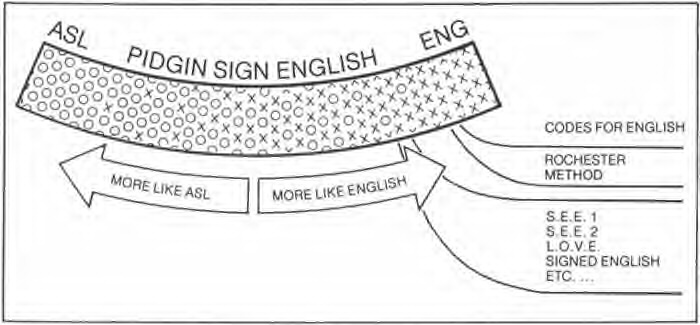
Various sorts of signed English (or "manually coded English") are listed here are:
- SEE 1: Seeing Essential English
- SEE 2: Signing Exact English
- LOVE: Linguistics of Visual English
- Signed English: a particular variety
- Rochester Method: fingerspelling every word (!) while speaking
Pidgin Signed English is said to be "what happens when (English-speaking) adults try to learn ASL." It has variable influences from English syntax, and lacks many of the grammatical and morphological features of ASL, as well as retaining many of the features of English.
However, young children exposed to Pidgin Signed English are said to acquire ASL, or something very much like it. This is similar to the way that hearing children exposed to native and non-native speakers of some language are able to develop native abilities, largely ignoring the imperfections in the non-native speech. You'll recall that Pinker has some discussion of this fact, and what it tells us about the human language instinct.
As an illustration, in signed English, the sign for "run" would be used in all of its English meanings, including:
"to go fast by foot"
Pat ran home.
"for liquid to flow"
The water is running.
"a tear in a stocking"
There's a run in your hose.
"to compete in an election"
Chris wants to run for president.
Because signed English is based on the spoken language, it preserves these homonyms (words with different meanings that all have the same form).
In many spoken languages, different words might be used for these meanings, most or all of them unrelated to one another.
| French | German | ||
| courir | laufen | (go fast by foot) | |
| couler | fliessen | (liquid flow) | |
| échelle | Laufmasche | (tear in stocking) | |
| poser sa candidature | kandidieren | (compete) |
Since ASL is a different language from English, it also has different signs for all these meanings.
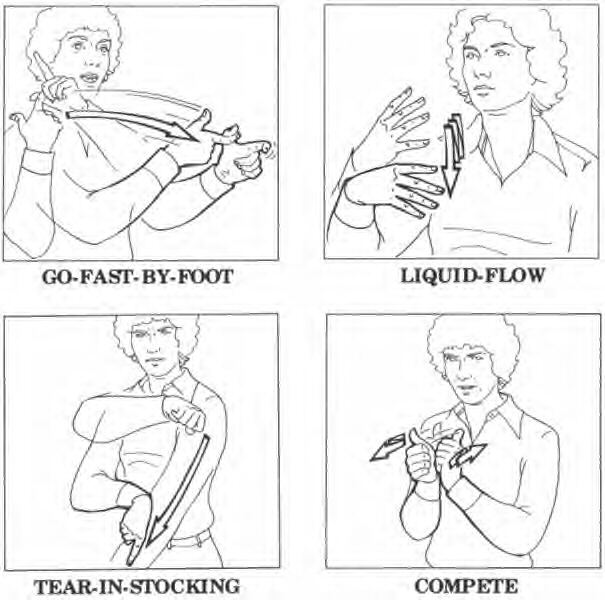
While the vocabulary of ASL has been influenced by that of English -- just as any two languages in contact show influence -- its lexicon exists independent of English.
Naturally, the various kinds of signed English are intended not as methods of communication in themselves, but rather as ways of teaching deaf people to use English in spoken or written form. This is the oralist tradition of education, which has a checkered past and is controversial today in the Deaf community.
For a hundred years or more, there has been a debate about deaf education between "oralists" and "manualists." As recently as 20 years ago, there were many oralist schools for the deaf where signing was prohibited (on the grounds that it lessened the motivation for deaf children to learn to speak and to lip-read).
Nevertheless, children in these schools would communicate privately in signed languages, which often were largely invented by the children at each school.
Today, the debate in the U.S. has swung so far back in the other direction that some Deaf activists oppose lip reading, hearing aids, and other medical intervention, arguing that the culture of the Deaf community has progressed to the point where attempts to cure or even ameliorate the condition of deafness are a kind of cultural genocide. This lengthy New York Times article on the subject is well worth the time to read.
An orthographic note: for many authors, the capitalized form Deaf is used to reflect cultural affiliation with the Deaf community; the simple form deaf is to describe a physical condition, independent of the cultural situation.
ASL and other sign languages have only been studied carefully by linguists for about 30 years. In the beginning, one of the key issues was to overcome "oralist" prejudices against sign, and to demonstrate its status as a "real" language, as opposed to a form of mime or charades. As a result, much of the work focused on issues of phonology-like aspects of ASL (such as its use of a fixed repertory of hand shapes and motion types), and on fairly direct ASL analogues to morphology and syntax. More recently, linguists have begun to explore some of the fascinating ways in which the visual-spatial medium of sign is used to express linguistic structure in ways not available in the auditory-acoustic medium of speech.
Fingerspelling
One way in which English plays an active role in ASL is through fingerspelling: the use of manual signs to spell out words according to English orthography.



The signs partly resemble written letters, but in many cases seem (in their current form) arbitrary. Most are just static handshapes, but two (J and Z) incorporate movement.
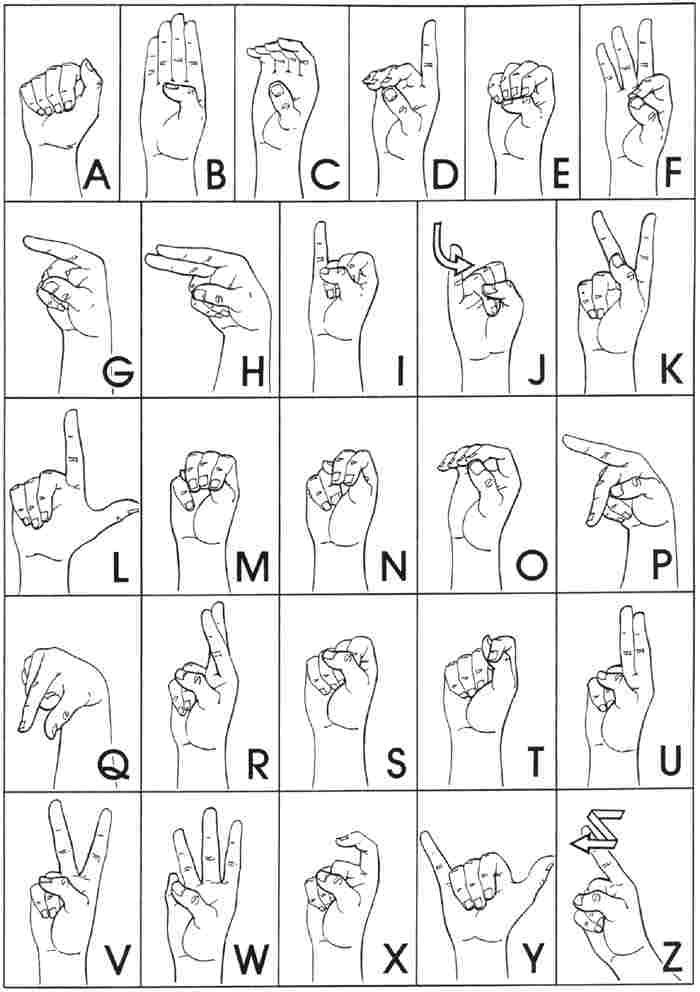
Humphries, Padden, and O'Rourke, 1980, A Basic Course in ASL.
Notice how different British Sign Language is, based just on the manual alphabet. One major difference is that nearly all the BSL signs require two hands, whereas all the ASL letter signs use just one hand.

Margaret Deuchar, British Sign Language.
For nice animated photos of these alphabets, see web pages for the ASL letter signs and the BSL letter signs.
Iconicity
There are two important kinds of iconicity in spoken language -- whereby the form of some word reflects its meaning, however tenuously.
Sound symbolism is one type of iconicity. For example, vowels with a small opening in the vocal tract have a slight tendency to be associated with small things or meanings (little), while vowels with large openings are more associated with big things or meanings (large). Most words do not reflect this tendency: cf. big and small!
Onomatopoeia is another type, since here the name sounds like the thing it refers to. Many birds take names that evoke their call (cuckoo, chickadee, whooping crane), and the names of sounds often are onomatopoeic (boom, splat, snort, tick-tock). There is still a significant arbitrariness -- not all languages use the same words for these birds and sounds! -- but there's an influence on the sound of the word.
There are, of course, degrees of iconicity in visual symbols.
It's crucial to realize that sign language is not just gestures that resemble the thing they refer to. While iconicity played a role -- sometimes a central one -- in the origin of many signs, there is also a great deal of arbitrariness, just as in spoken language.
Consider the sign in Chinese Sign Language for TREE.
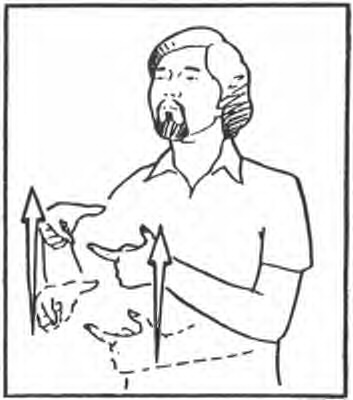
And in Danish Sign Language.

And finally in American Sign Language.
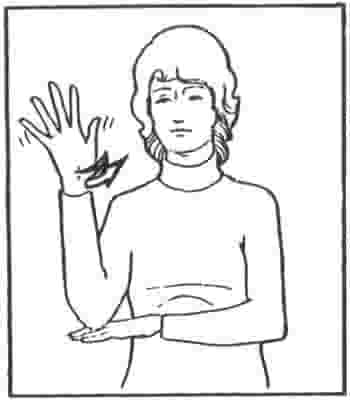
In all of these we can see the physical shape of a tree (=iconic), but it is evoked in quite different ways (=arbitrary). Indeed, if we did not know that these signs meant tree and were asked to guess their meaning, there are many other words we might come up with just as easily as "tree".
The particular sign is fixed for each sign language, so that the iconic origin is essentially irrelevant for the normal use of the sign.
There is also a tendency for the iconic origin of a sign to be obscured over time, such as when a sign consisting of two parts is merged into one unit.
The same tendency is found in spoken language, whereby the components of a word take on a different history from their independent relatives due especially to sound change. Example: lord was, in Old English, a compound noun hlafweard, made up of hlaf "bread" (= modern loaf) plus weard "guardian" (= modern ward), meaning something like "protector of the food supply". But subsequent changes in the sound and meaning of the word have completely obscured its origin, such that only a linguist would know that it was once a compound, let alone what the constituent elements were.
Entirely analogous is the earlier compound sign in ASL for HOME, which consists of EAT and BED in succession.
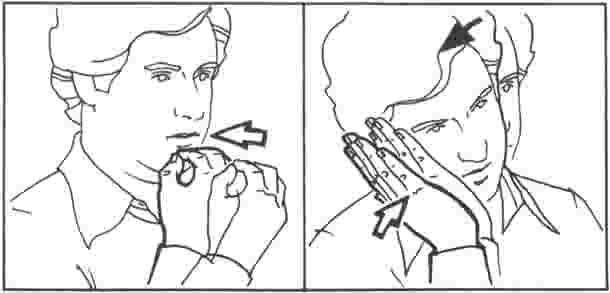
This is iconic because it partly encodes the meaning of the main word -- the place where eating and sleeping take place.
Today, the sign is more often used in a reduced form, which combines the handshape for "eat" with the location for "bed."
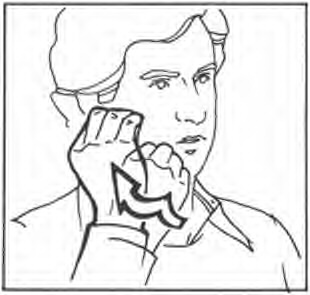
The new sign obscures its origin, just as the reduced pronunciation of lord obscures its origin. It's important to understand that ASL, like other sign languages, is not vague mimicry but rather a complex language that uses gesture rather than sound.
Handshapes
An important fact about sign languages, which further demonstrates their status as full human languages, is that each one has a finite inventory of basic handshapes out of which signs are made. This is entirely analogous to the way that spoken languages have finite inventories of phonemes out of which their morphemes are made.
Here are the unmarked handshapes in ASL. That means they are used more frequently, are especially common for the non-dominant hand, and tend to be preferred as the end-point of change over time. Deaf children also learn to make these signs first.
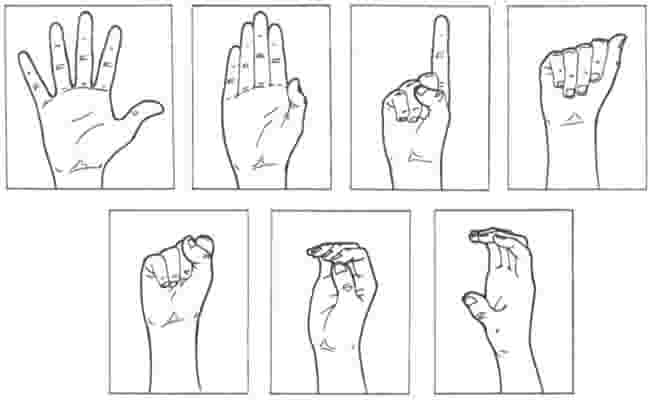
These additional shapes are marked. They are generally restricted to the dominant hand, and occur less often overall.
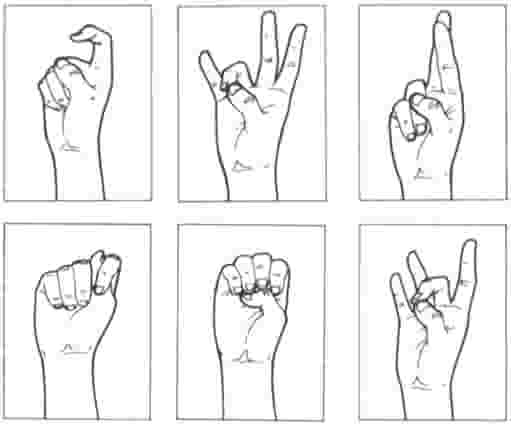
While some other handshapes occur as well, the great majority of signs consist of this quite restricted set of shapes.
Again, these are rather like the individual sounds of spoken language. Just as the human mouth can make far more sounds than are exploited in English, so the human hand can make far more shapes than are exploited in ASL.
Here are two handshapes in Taiwan Sign Language, in the signs for BROTHER and SISTER. They do not occur as standard handshapes in ASL, though you can imagine creative uses of the first one based on the more general use of that sign in American culture.
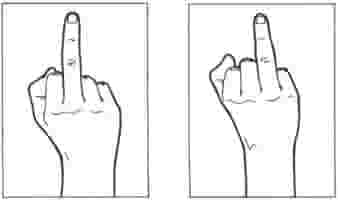
In both spoken and signed language, the natural tendency toward abstract categorization -- reduction of infinite physical possibility to a small number of distinctive categories -- is strongly evident. It's just that the modality is different here: handshape rather than vocal articulation.
Contact
Another basic property of signs is what part of the handshape makes contact. The rules of contact differ among sign languages, just as handshapes do.
The following examples from Chinese Sign Language make use of the same F handshape found in ASL.

But in ASL, contact is not normally made with the extended fingers in this handshape. Rather, contact is with the thumb and index finger, as in the sign for cat. Such restrictions are analogous to syllable structure in spoken languages -- how elements can be combined.
Morphology
Recall that morphology refers to the internal structure of words, such as dogs which consists of dog + s. It turns out that sign language has morphology as well, in the sense of modificatons made to signs in order to fit the syntactic context, express things like tense and agreement, and derive words of one syntactic class from words of another. A simple example in ASL is the way nouns and verbs are often related.
In many cases, the verb is a single movement, while a related noun consists of two shorter versions of the same movement.
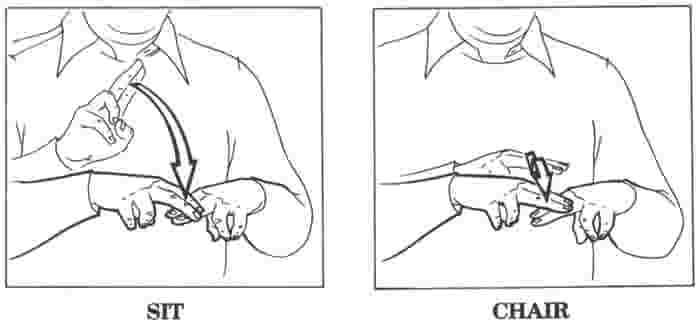
Many other verb-noun pairs are formed in a similar way, such as:
TO-NAME and a NAME
PUT-ON-DRESS and a DRESS
Other semantic features can be reflected in various kinds of patterns. Signs for male and female paired terms (such as MOTHER and FATHER) are often distinguished (at least in part) by the location of the same handshape:
at the chin for female
at the forehead for male
For examples, see mother and father in the on-line ASL dictionary. (You'll need to download the free QuickTime viewer to view the dictionary properly if you don't already have it installed. The dictionary site has instructions for how to do so.)
Recall that inflectional morphology does such things as marking the person and number in the verb. An English example is the addition of -s to a verb, as in talk-s. This is added to present-tense verbs when the subject is third-person singular (he, she, it).
In ASL, the subject and object of a verb are generally marked by use of the signing space. It's quite natural that ASL makes finer distinctions among participants in some situations than English, since the use of physical space is a powerful tool.
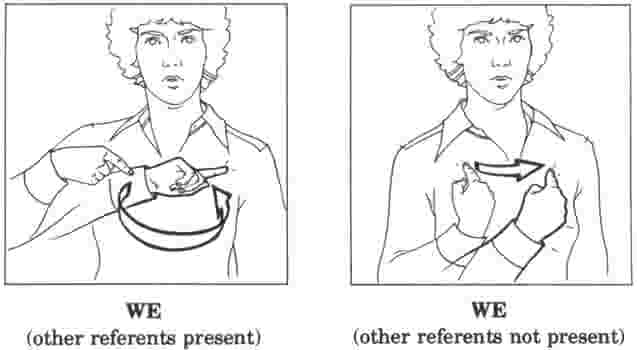
Of course, we've noted that some spoken languages (such as Mohawk) make this inclusive vs. exclusive distinction as well, but English does it only covertly in sentences like May we come in? versus May we go in?
For participants who are not present, the signer sets up an arbitrary location in space to use in referring to that person.
It's possible to specify one, two, three, four, and even five participants by using the symbol for that number as the pointing hand (though with five and sometimes four, many signers don't bother with the specific number -- just as most spoken languages don't).
Here are some examples of the ASL dual, i.e. exactly 2.
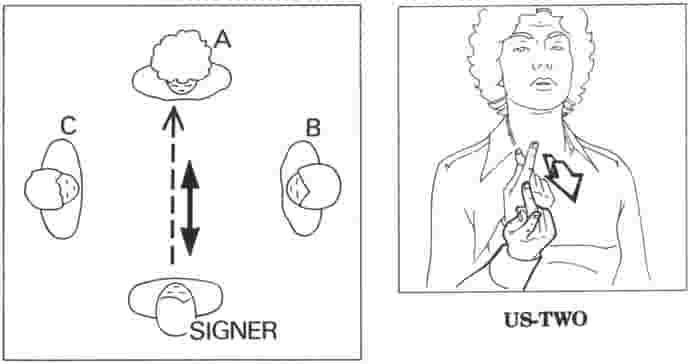

Many spoken languages have a dual number (for example Old English had wit "we two" versus we "we" and yit "you two" versus ye "you guys/y'all/youse"; more rarely one finds a "trial" that means exactly 3.
Many ASL verbs, called "directional," permit the person reference to be incorporated, so that movement of the basic handshape for the verb determines the participants. A common example is GIVE.
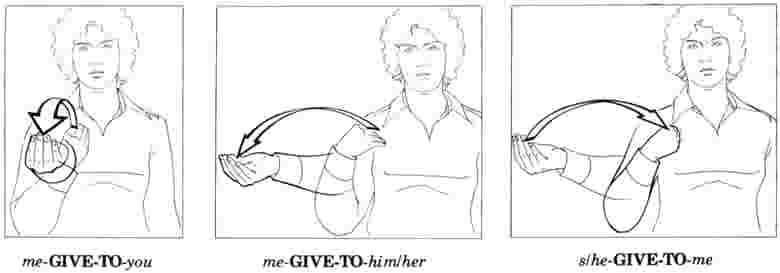

The same is true for LOOK-AT.
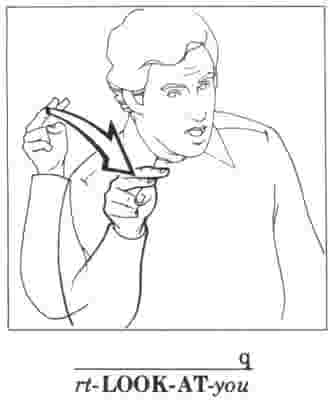
More specifically, this translates as s/he look at you? The "q" notation is used to indicate a question (as part of a careful transcription). In the absence of voice pitch to express intonation, sign languages like ASL use facial expression, in this case raised eyebrows.
Notice the use of two hands to express reciprocal action.

Each hand serves to describe one half of the action.
This is only a taste of the extremely rich morphology of ASL. Here is a paper that explains how head tilt and eye gaze are used to mark additional agreement-like phenomena. Along the way, the paper indicates some of the ways in which true ASL syntax differs from English. For instance, if the WH-word in an ASL question is displaced, it must be to the end of the clause rather than to the beginning: "John see yesterday who?"
Classifiers
Another aspect of ASL that takes advantage of the visual medium is the set of handshape modifications known as classifiers, which evoke the size and shape of an object.
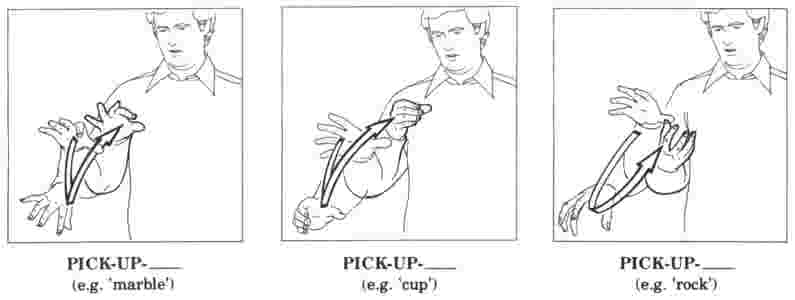
Note that the possible handshapes are still restricted to a defined set (because these shapes are part of the grammar, even though they originate in visually iconic gestures).
Also, it's worth noting that many spoken languages make fine distinctions regarding the size or shape of some item affected by a verb, often by adding a particular prefix. The meaning is similar to what's found in ASL, but in spoken language it's much less iconic.
Social variation
Spoken language varies according to various aspects of society, including geography, gender, and race. The same is true of signed languages like ASL.
While the signs of ASL are largely shared throughout the country (as are the words of English), there are some instances of regional signs. Here are several for BIRTHDAY. (Another strategy is to sign BIRTH plus DAY.)
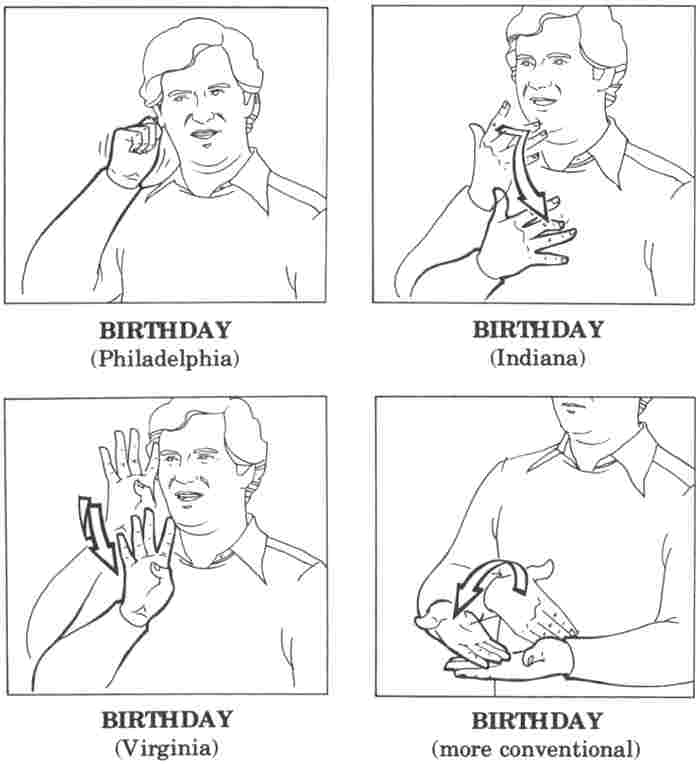
And for HALLOWEEN: note that all these signs clearly refer to a mask, but in distinct ways that are part of the grammatical structure of the language.
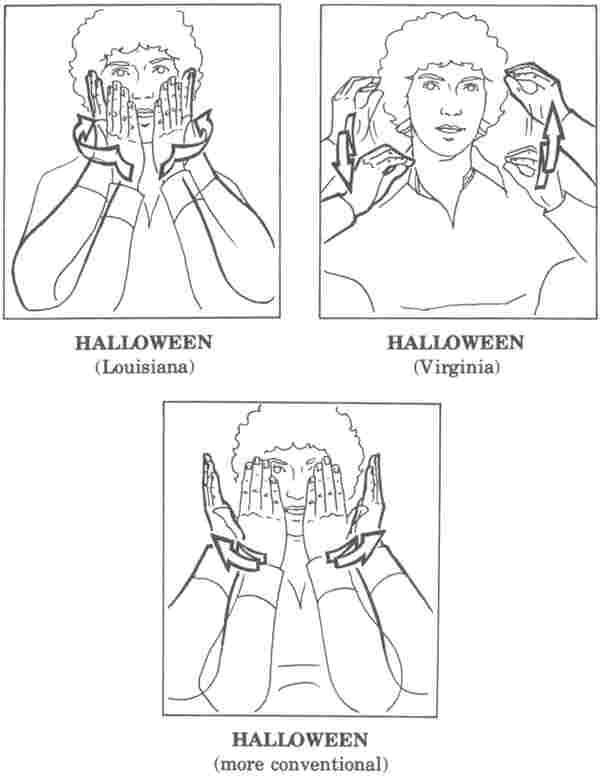
Similarly, there are differences in sign use based on race. This is particularly to be expected given that schools for the deaf were for some time segregated in the South.

And finally, there are differences in sign use based on gender. For example, one study found that men were more likely to use several newer signs, while women tended to use the older form of the same sign. (The older ASL form of HELP, by the way, is nearly identical to the sign still used in French Sign Language.)

As in spoken language, emotive vocabularly (such as lovely) is especially likely to show gender differences. These two forms of TERRIFIC are used especially when talking about sports events, and males and females at Gallaudet University tend to use different signs.
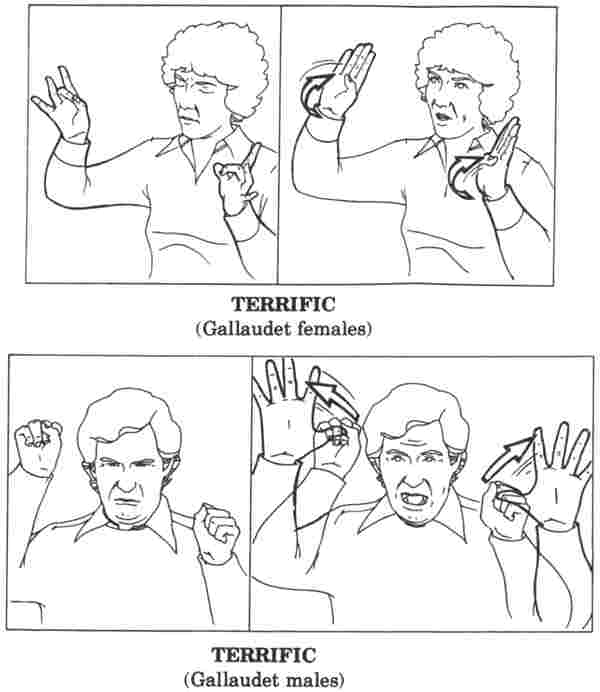
Gallaudet University, located in Washington, DC, is the world's most prestigious center of learning for Deaf students, and is a very important unifying factor in ASL.
Language, Thought and Culture.
The question of how the language we speak reflects or influences our view of the world, or our very thought processes, is one of considerable interest to many people but also a difficult one to answer. In this lecture we'll consider various points of view, and some evidence that's relevant in assessing them.
The Sapir-Whorf hypothesis can be stated in this way.
- Structural differences between language systems will, in general, be paralleled by nonlinguistic cognitive differences, of an unspecified sort, in the native speakers of the two languages.
- The structure of anyone's native language strongly influences or fully determines the world-view he or she will acquire while learning the language.
It's possible to make strong or weak versions of these claims. The strong version is clearly false, and most linguists feel that the versions that are weak enough to be plausible aren't very interesting.
Pinker gives a range of evidence against the view that language is what we use for thinking. It can be summarized as follows.
- Supposed limitations on expression in various languages are based on
faulty linguistic understanding.
- Hopi does have words for time, etc.
- Translation between languages is possible (even if difficult to do elegantly).
- Thought is possible without language.
- Adults who have grown up without language.
- Babies before they learn language.
- Primates and other animals that never learn language.
- Adults who reason and create in visual or other modes.
- Language is an inadequate medium for the
direct encoding of thought.
- We often can't think of the right word to express ourselves.
- Language contains ambiguity, homophony, etc.
- Manipulation of visual images is done directly.
Instead, thought is encoded in something distinct from normal language, which he calls mentalese. Today we'll talk about a few examples, which partly overlap with Pinker's discussion.
Language as a reflection of culture
One obvious way in which languages may differ is in the nature of their vocabulary. A famous example -- often mischaracterized -- is the number of Eskimo words for "snow."
This issue was first brought to scholarly attention in 1911 by the anthropologist and linguist Franz Boas, in the introduction to his book The Handbook of North American Indians, Boas said that Eskimos have four different words for snow, where English has just one.
aput for snow on the ground
qana for falling snow
piqsirpoq for drifting snow
qimuqsuq for a snowdrift
English can only make similar distinctions by modifying the basic word snow, as in the translations given.
Boas didn't make too much of this observation, but Benjamin Lee Whorf -- an amateur linguist who was convinced that language had a strong effect on thought -- focused on the lack of a common term in Eskimo. Writing in Technology Review:
"We have the same word for falling snow, snow on the ground, snow packed hard like ice, slushy snow, wind-driven flying snow -- whatever the situation may be. To an Eskimo, this all-inclusive word would be almost unthinkable; he would say that falling snow, slushy snow, and so on, are sensuously and operationally different, different things to contend with; he uses different words for them and for other kinds of snow."
The difference in vocabulary is taken by Whorf as evidence for a difference in attitude or perception. (It's important to note that he did not investigate what the actual attitudes or perceptions were, severely undermining the basis of his claim.)
Over the years the claims regarding the number of words for "snow" in Eskimo have become more and more outlandish, ranging up to the hundreds. Even if true, this fact would not be of much interest, any more than the fact that farmers have lots of words for farm implements, and doctors know lots of words for diseases.
But in fact, setting aside complications in actually coming up with a firm number, there are perhaps 12-15 words in Eskimo for snow and related phenomena. (See this discussion of the details by an expert in Eskimo languages.)
That's not much different from what we can find in English. As in Eskimo, some of these words have other meanings unrelated to snow.
avalanche
blizzard
dusting
flurry
frost
hail
hardpack
powder
sleet
slush
etc.
The real point, as Boas and Whorf originally made it, refers to the way the two languages divide up the world. It's true that Eskimo uses unrelated words to name snow that's falling and snow that's already on the ground. These examples are from Central Alaskan Yupik, one of the five Eskimo languages.
qanuk = "falling snow, snowflake"
aniu = "snow on the ground"
In English, of course, one word describes both of these: if you say "look at the snow!" you could be referring to either type.
| English | Yupik |
| snow | qanuk |
| aniu |
It's not as though we don't know the difference! The context typically makes it clear, and adding words will distinguish the two.
"look at all that snow coming down!"
"look at all the snow piled up on the ground!"
Obviously having a single word doesn't mean you can't conceive of subtypes of the same thing. But what about the converse: Does the lack of a common term inhibit thinking about two things as similar?
It should be noted that claims like this have typically been made about cultures other than the one to which the researcher belongs. At best, it's a fascination with the "exotic" that encourages these claims. More troublingly, to the extent these claims imply more limited thought processes, it's hard not to see them as racist.
A final note about Yupik: the root qanuk- for "falling snow" also exists in derived form qanikcaq- meaning "snow on the ground". Obviously they're considered to be the same thing.
Thus, while we can point out things about Eskimo words for "snow," it's not so different from the situation in Ancient Greek.
neíphein = "to snow"
niphás = "snowflake"khiôn = "snow (on the ground or falling)"
The basic word for "snow" is unrelated to the verb, and to "snowflake." But does that mean Plato didn't realize their connection? Funny how Whorf never made that claim.
We could make the same point about these words in English, which are unrelated to one another as words but not as things in the world. (Boas gives similar examples as a parallel to Eskimo snow.)
water
rain
puddle
dew
wave
foam
river
stream
lake
ocean
We realize that rain is water falling from the sky, and that snow is a related phenomenon, even though there's no independent cover term for them. (Precipitation is a modern scientific term, and literally just means "things that fall.")
We know this because we can observe rain turning to snow as the temperature changes, as we can see water turning to ice when it's on the ground.
Notice here we distinguish falling rain from water on the ground!
And rainwater is a kind of water, not a kind of rain.
The specific vocabulary items aren't what determine our understanding of the world. If we were Martian linguists, perhaps we would marvel at the quaint English language and how many different words it has for water in various shapes and sizes -- even though it's all just H2O! Water must be really important in England.
Categorizing the world
The idea that the vocabulary of a language traps its speakers into thinking only in those terms is easily disproved. For example, in English animal terms, there's a different range of detail available for various animals. Here's a basic schema.
| species | |||
| immature | mature | ||
| male | female | male | female |
Let's start with humans, which are the most elaborately described species. (There are, of course, other categories such as adolescent, not discussed here.)
| person, human, man* | |||
| child | adult | ||
| boy | girl | man | woman |
In a certain style of use, often considered to be sexist today, there's overlap in the terminology, since man is used for a superordinate category (as in man's inhumanity to man).
That makes the word polysemous for those who use it in this fashion: it has more than one meaning. These are marked with an asterisk (*).
Various sorts of overlap are typical for animals. It's not surprising that the vocabulary is limited for animals with which English speakers have minimal contact, and more elaborate for animals with a greater cultural importance -- including humans!
Consider first an animal of cultural importance, the horse. (There are more specialized terms, such as gelding, that are not considered here because they encode other types of meaning. The same goes for some of the other animals below.)
| horse | |||
| foal | horse* | ||
| colt | filly | stallion | mare |
The word horse is thus polysemous: it can mean "adult horse" or just "horse" regardless of age. This is the most common pattern for English animal terms.
Other animals have just one term for the immature animal, regardless of sex. Does that mean that speakers of English think sheep have no sexual differences until maturity? No, it just means the language doesn't bother to express a notion that is nevertheless understood.
|
| |||
|
|
| ||
|
|
| ||
For most animals, such as elephant, only one basic term exists.
|
elephant | |||
Adoption of terms from other species is necessary to create distinctions when necessary, such as cows. Again, this shows awareness of the concepts even in the absence of special vocabulary.
|
| |||
|
|
| ||
|
|
| ||
Interestingly, the most general category isn't actually very well handled in English for cows.
|
| |||
|
|
| ||
|
|
| ||
There are two possibilities for the general term:
- cow: ranchers generally use this term only for the female, but it's typically the general term for the layperson.
- cattle: this is a non-count noun, so it's not possible to say *a cattle; instead one has to count head of cattle, which means that general term ends up being the quite nonspecific head.
So for this animal we lack the simple equivalent of horse, but we can still understand the difference between cows (or cattle) in general and specifically female animals of the species.
Given any pair of languages, it's always possible to find a semantic distinction that's made in one but not the other. Take, for example, Russian and English.
Russian distinguishes two kinds of blue, darker and lighter, without a common term for them (other than sinij, which can sometimes serve that function).
| English | Russian |
|
blue |
sínij |
| golubój |
Of course, English can use a longer phrase to make a similar distinction, but it's done by modifying the general term.
| English | Russian |
| dark blue | sínij |
| light blue | golubój |
Conversely, Russian (like many languages) uses the same word for hand and arm.
| English | Russian |
| hand |
ruká |
| arm |
Examples of the general character of ruká can be found in various expressions (showing different case forms of the noun) and derived words.
v ruké "in one's hand"
zá ruku "by the hand"brat' ná ruki "lift up in one's arms"
idtí pód ruku "walk arm in arm"rukáv "sleeve"
rukavítsa "mitten"
Notice that the choice of preposition helps distinguish the two basic senses. But Russian, like English for blue, can be more specific if necessary.
| English | Russian |
| hand | kist' "cluster, brush, hand" |
| arm | ruká "hand, arm (especially)" |
Such examples could easily be multiplied.
Color perception
Languages differ in the way they split up the range of possible colors by means of color terms. Research on this issue often draws on sets of color chips, such as the following.
A useful experiment about the possible effect of color vocabulary on perception was done with speakers of English and Tarahumara, a native language of northern Mexico (Kay and Kempton 1984).
English, of course, has the two words green and blue among its eleven basic color terms.
Tarahumara, like many languages, has a single term that covers this range of color, siyóname. (Sometimes such words are translated as "grue," from green+blue. Here it's labeled "green.")
![]()
One might ask, then, whether speakers of the two languages in some way perceive the difference between these colors differently.
Experiment I
Subjects were shown three close colors in the blue-green range, and asked to choose the one that's most different from the other two. For example:
| A | B | C |
English speakers were found to be biased to group colors according to the words "green" and "blue,", while Tarahumara speakers were not. That is, even when the middle color B was objectively closer to A than to C, an English speaker often would identify BC as the closest pairing if they both could be described by the same word. This happened only when the differences were subtle.
The explanation seems to be that, faced with difficult discriminatory task, people unconsciously look for another (easier) means of deciding, in this case by using the name strategy. So can this strategy be prevented, in order to test true perception?
Experiment II
In a second experiment, English speakers were shown only two of three adjacent colors at once, and asked to compare the degree to which A is greener than B:
| A | B |
and the degree to which C is bluer than B:
| B | C |
This time, there was no significant effect of vocabulary. That is, the same results were obtained whether or not B fell close to the boundary between green and blue.
The explanation is that the name strategy is pre-empted here since the instructions incorporate the color terms. Thus the language you speak can have an effect on the way you answer a question or perform a task, but does not prevent you from seeing things as they are once the interference from the language is removed.
"Thinking for speaking"
Traditional descriptions of the relation between thought and language take a fairly static view.
"There resides in every language a characteristic world-view.... Man lives primarily with objects, [but] he actually does so exclusively as language presents them to him." (Wilhelm von Humboldt, 1836)
"Users of markedly different grammars are pointed by their grammars towards different types of observations and different evaluations of externally similar acts of observation, and hence are not equivalent as observers but must arrive at somewhat different views of the world." (Benjamin Lee Whorf, 1940)
Experiments suggest that the relevant issue is not thought (a static notion) so much as thinking, i.e. the specific task one is performing (a more dynamic notion). In particular, when you're expressing thoughts in a particular language, you necessarily have to respect the important categories of that language, but if you choose you can include whatever extra information you want (Slobin 1996).
For example, some languages tend to express many aspectual distinctions, i.e. information about the internal temporal structure of an event. English happens to be fairly rich in this domain.
I went
I was going
I had gone
I will have gone
I will be going
etc.
In describing a picture like the following, English speakers normally make use of such distinctions.
English speakers say, for example:
The boy fell out... and the dog was being chased by the bees. (5 years old)
He's [the dog is] running through there, and he [the boy] fell off. (3 years, 8 months old)
Spanish speakers make similar distinctions.
Se cayó el niño y le perseguían al perro las avispas. (5 years old)
"The boy fell and the wasps were chasing the dog."
Se cayó... El perro está corriendo. (3 years, 4 months old)
"The boy fell... The dog was running."
Other languages, however, don't have verb inflections that make these distinctions so easy to express. In German, for example, the following verb forms are equivalent to more than one English verb aspect.
fällt = "falls" or "is falling"
ist gefallen = "fell" or "has fallen" or "was falling"rennt = "runs" or "is running"
rannte = "ran" or "has run" or "was running"
When faced with the task of describing such a picture, German speakers often resort to indirect strategies such as the following:
Der ist vom Baum runtergefallen und der Hund läuft schnell weg. (5 years old)
"He fell down from the tree and the dog runs away quicky"Er rannte schneller und immer schneller. (9 years old)
"He ran faster and faster"Der Hund rennt rennt rennt. (adult)
"The dog runs runs runs"
A similar situation holds in Hebrew, where a speaker might or might not choose to distinguish the two actions.
Hu nafal ve hakelev barax. (5 years old)
"He fell and the dog ran away"
Hayeled nafal... ve hakelev boreax. (5 years old)
"The boy fell... and the dog runs away"
Thus all speakers are clearly aware of the aspect in the scenes, but they usually express only those aspectual distinctions that are built into the language. It's just a tendency, though:
one-fourth of the time, English and Spanish speakers fail to use relevant distinctions in their languages; and
three-fourths of the time, German and Hebrew speakers go out of their way to indicate the aspect indirectly.
First-language thinking is often found in second-language speaking: Slobin comments that
"once our minds have been trained in taking particular points of view for the purposes of speaking, it is exceptionally difficult for us to be retrained."
The difficulty of learning different distinctions in a second language results from linguistic habits transferred from one language to another, just as accent is the transfer of pronunciation habits. This is one way, then, in which the language we speak affects our thought processes. But the other evidence also shows that these are habits, rather than rigid limits.
Germanic prepositions
Discussions of Sapir-Whorf typically focus on different cultures that also have different linguistic properties (such as English and Tarahumara). But quite similar cultures can also have significantly different linguistic properties, in which case it's rather implausible that the thought processes of the speakers are so different.
Consider some spatial prepositions from three West Germanic languages, which are linguistically and culturally closely related. They would be used to express some of the relationships seen in these drawings.
In German, two prepositions that would be rendered by English "on" are used, depending on the orientation of the surface to which something is attached (or in contact).
auf = horizontal surface
cup on a table
spider on a ceiling
band-aid on shoulderan = vertical surface, or no clear orientation
picture, poster on a wall
band-aid on leg
raindrops on a window
fly on a window
leaves on a twig
In Dutch, on the other hand, the related prepositions are chosen depending on the method of attachment.
aan = attached by a fixed point; prevented from manifesting tendency toward separation
clothes on a line
coathook on a wall
picture on a wall (hanging from a nail)
apple on a twig
icicles on a roof
handle on a pan
dog on a leash
pull-toy on a string
balloon on a stringop = supported from underneath (i.e. horizontally), or broadly on flattish surface, or living creature; seen as essentially stable
cup on a table
bandaid on a leg or shoulder
poster on a wall (glued tight)
sticker on a refrigerator
paint on a door
raindrops on a windowfly on a window
spider on a ceiling
snail on a wall
In English, of course, on is used for all of these relations. But the cultural and scientific traditions of Germany, Holland, and England are closely related and very similar. (Whorf considers them all as part of "Standard Average European" culture.)
If these fundamental spatial distinctions don't indicate differences in thought, then it's doubtful that any more "exotic" distinctions indicate anything significant about thought processes. Speakers of German or Dutch have to attend to these issues of orientation or attachment when choosing a preposition, but speakers of all languages understand the underlying concepts.
|
For further information Some links related to topics in this lecture:
|
homework
